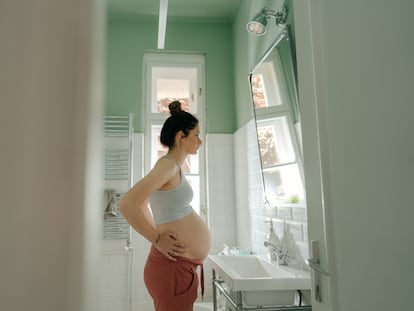‘Matrescence’ or how mothers’ brains change up to six years after giving birth
Motherhood is a period of neuroplasticity and mental vulnerability that help women adapt to the enormous requirements of a baby’s arrival

We know that motherhood is a huge change, and not only at the personal, family and social levels. During pregnancy, the body adapts to different cardiovascular, respiratory, metabolic, renal and muscular changes. But the brain also undergoes enormous modifications. Multiple recent research studies have analyzed how mothers’ brains prepare to care for a baby. Hormones bring about profound changes, triggering an increase in neuroplasticity. This is a process similar to the one that occurs during adolescence; it is known as matrescence, a term coined by anthropologist Dana Raphael in the 1970s, and recently the concept has been gaining traction.
“Just as adolescence describes a child’s transition to adulthood, matrescence describes a woman’s transition to motherhood. Adolescence and matrescence are both periods coordinated by steroid hormones, and times of neuroplasticity and mental vulnerability. In addition, both are moments of change and adaptation, although what each person experiences individually varies widely,” explains neuroscientist Magdalena Martínez García, who works with the neuroimaging groups at Neuromaternal (Madrid) and BeMother (Barcelona). These organizations have conducted pioneering longitudinal studies of mothers’ brains during different periods, from pre-pregnancy through gestation to postpartum. A 2019 study in which Martinez participated showed that the similarities between adolescence and matrescence also have a neurobiological basis. “We compared the brain changes in a group of first-time mothers and those in a group of adolescent girls. Surprisingly, both groups showed a virtually identical profile of change, suggesting that adolescence and matrescence involve similar neuroplasticity processes and steroid hormones are important mediators of these changes,” she says.
According to Susanna Carmona Cabañete, a clinical psychologist, PhD in Neuroscience and the director of the Neuromaternal research group at the Gregorio Marañón Health Research Institute, a woman’s first pregnancy drastically alters her brain. “The brain changes during this vital period are so pronounced that the scientific community currently considers pregnancy to be the stage of greatest brain plasticity in adult life,” she says. According to the expert, this is a period in which the brain is more malleable and adaptable to experience. Hormonal fluctuations and interactions with the baby are behind this enhanced malleability: “The former prepare the brain to become more plastic; the latter exert pressure to mold and adapt it to the demands of the new stage.”
Carmona likens the process to pottery, encouraging us to think of the brain as a lump of clay just removed from the package, moist and extremely vulnerable to external events like us pressing and stretching it. “Over time that clay loses moisture as well as malleability, the ability to adapt. The brain is fixed, the main structure of the sculpture is already formed, and only subtle changes can be made. Until recently, it was believed that after adolescence, that clay was baked and remained fixed, subject only to the wear and tear of the passage of time. Today, we know that this baking does not occur and that small changes in the brain’s anatomy and function will continue to occur until death,” she explains.
In pregnancy, the maternal brain becomes malleable again to encourage adaptation to the enormous demands of a baby’s arrival. These requirements often conflict with how many women experience moments like pregnancy, childbirth and, of course, the postpartum period. “The brain is constantly adapting to both our internal state and our environment. And often what your body asks of you clashes with your socioeconomic situation, including your family situation and your working conditions. Currently, we experience motherhood with a constant ambivalence between privilege and precariousness,” says Magdalena Martínez.
The neuroscientist’s studies have found that mothers’ brains continue to change throughout the postpartum period and therefore remain vulnerable during that time and even several years later. In a study published in Brain Sciences in 2021, the researcher found that a mother’s brain differs from that of a childless woman for up to six years after giving birth. Other studies on women in adulthood (decades after becoming mothers) suggest that pregnancy leaves a permanent imprint on women’s brains.
Taking better care of mothers
Protecting women during pregnancy to avoid stress and improve rest is essential. Magdalena Martínez thinks that society has traditionally focused on the negative impact of pregnancy and motherhood on women’s cognitive ability “to the point of normalizing the term mommy brain and momnesia in reference to pregnant women.” In addition, she believes that this type of research is a reminder of the tremendous changes in the brain that pregnancy and postpartum entail, putting the loss of memory and concentration that women may experience into perspective.
“These studies have shone a spotlight on mothers, the great forgotten, who often tend to take a back seat to the baby. We have to understand that a good support and care network of family, friends and healthcare personnel is fundamental to the well-being of both mothers and their babies,” she adds. In addition, Martínez continues, if we understand how mothers adapt to these changes in a non-pathological way, “we’ll understand how we can support those who suffer from mental health disorders like postpartum depression, for example, which affects 20% of mothers.”
How are surrogate mothers affected by these changes? Martínez explains that there are no studies on the brains of these pregnant mothers because she believes that it is not in their best interest to explore them; however, she does think that it would be interesting to see what impact a premeditated separation from the baby after birth has on their mental and cerebral health in the short and long terms. In this regard, Susanna Carmona reminds us that the hormonal and immune changes that occur during pregnancy leave a lasting impact on the maternal brain, which can alter the mother’s mental health in the short and long term.
In other words, gestation brings a series of adaptations in the body and brain that seem to persist for life and can impact the health of both the pregnant mother and the baby. “Pregnancy is a natural process, but that does not mean that we should trivialize its effect on a woman’s physiology,” says Carmona. On several occasions, Ibone Olza, a psychiatrist and the director of the European Institute of Perinatal Mental Health, has pointed out the repercussions that separating the mother-baby dyad can have on perinatal mental health: “It involves…a series of losses for both, which is why I insist on the need for further research on the consequences of this practice.”
Sign up for our weekly newsletter to get more English-language news coverage from EL PAÍS USA Edition
Tu suscripción se está usando en otro dispositivo
¿Quieres añadir otro usuario a tu suscripción?
Si continúas leyendo en este dispositivo, no se podrá leer en el otro.
FlechaTu suscripción se está usando en otro dispositivo y solo puedes acceder a EL PAÍS desde un dispositivo a la vez.
Si quieres compartir tu cuenta, cambia tu suscripción a la modalidad Premium, así podrás añadir otro usuario. Cada uno accederá con su propia cuenta de email, lo que os permitirá personalizar vuestra experiencia en EL PAÍS.
¿Tienes una suscripción de empresa? Accede aquí para contratar más cuentas.
En el caso de no saber quién está usando tu cuenta, te recomendamos cambiar tu contraseña aquí.
Si decides continuar compartiendo tu cuenta, este mensaje se mostrará en tu dispositivo y en el de la otra persona que está usando tu cuenta de forma indefinida, afectando a tu experiencia de lectura. Puedes consultar aquí los términos y condiciones de la suscripción digital.
More information
Últimas noticias
Most viewed
- David King, chemist: ‘There are scientists studying how to cool the planet; nobody should stop these experiments from happening’
- Reinhard Genzel, Nobel laureate in physics: ‘One-minute videos will never give you the truth’
- Mexico completes its trade shift with the entry into force of tariffs on China and countries without trade agreements
- Oona Chaplin: ‘I told James Cameron that I was living in a treehouse and starting a permaculture project with a friend’
- Sinaloa Cartel war is taking its toll on Los Chapitos











































